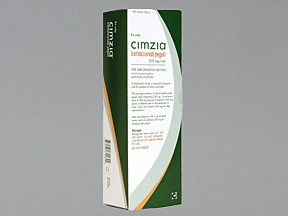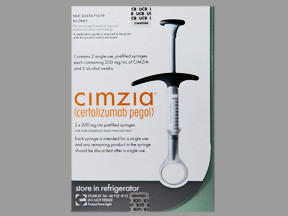CERTOLIZUMAB - INJECTION
PHONETIC PRONUNCIATION: (SER-toe-LIZ-oo-mab)
COMMON BRAND NAME(S): Cimzia
GENERIC NAME(S): certolizumab pegol
Uses
USES: This medication is used to reduce pain and swelling due to certain inflammatory conditions (such as rheumatoid arthritis, psoriatic arthritis, ankylosing spondylitis). Some brands may also be used to treat plaque psoriasis or a certain bowel condition (Crohn's disease). Certolizumab belongs to a class of drugs known as tumor necrosis factor (TNF) blockers. It works by blocking TNF, a substance made by the body that causes inflammation.
How to use CERTOLIZUMAB - INJECTION
HOW TO USE: Read the Medication Guide and, if available, the Patient Information Leaflet provided by your pharmacist before you start using certolizumab and each time you get a refill. If you have any questions, consult your doctor or pharmacist. This medication is given by injection under the skin, in the stomach or thigh area, as directed by your doctor. Follow your doctor's directions and the schedule for your doses very carefully. Remove this medication from the refrigerator and leave at room temperature for 30 minutes before injecting. Do not warm up this medication in any other way such as heating in the microwave or placing in hot water. Do not inject into any areas of skin that are sore, bruised, red, scaly, or hard. If you are giving this medication to yourself at home, learn all preparation and usage instructions from your health care professional. Do not shake the medication. If you are using the vial, follow the instructions for adding the mixing liquid to the medication. Gently swirl the vial to mix. Before using, check this product visually for particles or discoloration. If either is present, do not use the liquid. Learn how to store and discard medical supplies safely. Use this medication regularly to get the most benefit from it. To help you remember, mark the days on a calendar when you need to receive the medication. Tell your doctor if your condition persists or worsens.
Side Effects
Precautions
Interactions
Overdose
Images
Reviews
Faq for CERTOLIZUMAB - INJECTION
Certolizumab is used to treat rheumatoid arthritis, psoriatic arthritis, ankylosing spondylitis, and Crohn's disease.
Certolizumab belongs to a class of drugs called tumor necrosis factor (TNF) inhibitors. It works by reducing inflammation in the body and suppressing the immune system.
Certolizumab is injected under the skin (subcutaneously). It is typically given every 2 to 4 weeks, depending on the condition being treated.
Common side effects of Certolizumab may include injection site reactions (redness, pain, swelling), upper respiratory infections, headache, and rash. Serious side effects may include infections, allergic reactions, and worsening heart failure.
It is important to discuss the risks and benefits of using Certolizumab during pregnancy or breastfeeding with your healthcare provider. Generally, the use of Certolizumab during pregnancy or breastfeeding is not recommended unless the benefits outweigh the risks.
The onset of action can vary depending on the condition being treated. Some patients may start to experience improvement within a few weeks, while others may take several months.
Certolizumab may be used in combination with other medications, such as methotrexate, to enhance its effectiveness. However, it is important to inform your healthcare provider about all the medications you are taking to avoid potential drug interactions.
Certolizumab is generally covered by most insurance plans. However, it is recommended to check with your insurance provider to confirm coverage and any potential restrictions.
Certolizumab should be stored in the refrigerator between 36°F and 46°F (2°C and 8°C). It should not be frozen. Prior to injection, the medication should be brought to room temperature for about 30 minutes.
Warning
WARNING: This medication can decrease your body's ability to fight an infection. This effect can lead to very serious (possibly fatal) infections (e.g., fungal infections, bacterial infections including tuberculosis). You should have a tuberculosis (TB) skin test before and during treatment with this medication. Also tell your doctor your medical history, especially of past/recent/current infections. You should also tell your doctor if you have lived or traveled in areas where certain fungal infections (e.g., coccidioidomycosis, histoplasmosis) are common or if you have been near someone with tuberculosis. See Side Effects section for symptoms of infections to watch out for, and seek immediate medical attention if you develop any of these symptoms. If you are diagnosed with TB, you must first be treated for it before you start certolizumab to prevent a serious TB infection. Though it is very unlikely to happen, there is a risk (especially in children/teens/young adults) of developing cancer (such as lymphoma, skin) due to this medication or due to your medical condition. Discuss the risks and benefits of treatment with your doctor. Tell your doctor right away if you develop symptoms such as unusual lumps/growths, skin changes, swollen glands, swollen or painful abdomen, unexplained weight loss, persistent fever or night sweats.
Disclaimer
IMPORTANT: HOW TO USE THIS INFORMATION: This is a summary and does NOT have all possible information about this product. This information does not assure that this product is safe, effective, or appropriate for you. This information is not individual medical advice and does not substitute for the advice of your health care professional. Always ask your health care professional for complete information about this product and your specific health needs.



No Reviews Yet